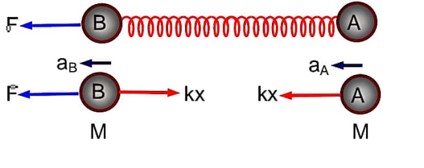Laws of Motion
Get insights from 109 questions on Laws of Motion, answered by students, alumni, and experts. You may also ask and answer any question you like about Laws of Motion
Follow Ask QuestionQuestions
Discussions
Active Users
Followers
New answer posted
2 months agoContributor-Level 10
Let the spring is in extension state and
Hence we can say that block moves away from block B in the frame of B
F – kx = MaB . (1)
kx = Ma . (2)

New answer posted
2 months agoContributor-Level 10
velocity of car at t = 4sec is
v = u + at
v = 0 + 5 (4)
= 20 m/s
At t = 6sec
acceleration is due to gravity ∴ a = g = 10 m/s
v? = 20 m/s (due to car)
v? = u + at
= 0 + g (2) (downward)
= 20 m/s (downward)
v = √ (v? ² + v? ²)
= √ (20² + 20²)
= 20√2 m/s
New answer posted
2 months agoContributor-Level 10
By Conservation of Angular Momentum (COAM) about O, just before and after the collision:
Initial angular momentum L? = mv?
Final angular momentum L? = Iω? = (I_rod + I_block)ω? = (M? ²/3 + m? ²)ω?
L? = L?
mv? = (M? ²/3 + m? ²)ω?
ω? = mv / (M? /3 + m? ) = (16) / (21/3 + 1*1) = 6 / (5/3) = 18/5 rad/s
By Conservation of Total Mechanical Energy (COTME) after collision until it comes to rest:
Initial Energy (at the lowest point) = Rotational K.E. = (1/2)Iω? ²
Final Energy (at the highest point) = Potential Energy = mgh_m + Mg h_M
mgh_m = mg (? -? cosθ)
Mg h_M = Mg (? /2 - (? /2)cosθ)
(1/2) * (M? ²/3 + m? ²) * ω? ² = (mg + Mg/2) *
New answer posted
2 months agoContributor-Level 10
From momentum conservation
mui + 0 = mvj + 3mv'
v' = u/3 I - v/3 j
From kinetic energy conservation 1/2 mu² = 1/2 mv² + 1/2 (3m) (u/3)²+ (v/3)²)
Solving, v = u/√2
Taking an Exam? Selecting a College?
Get authentic answers from experts, students and alumni that you won't find anywhere else
Sign Up on ShikshaOn Shiksha, get access to
- 65k Colleges
- 1.2k Exams
- 679k Reviews
- 1800k Answers


